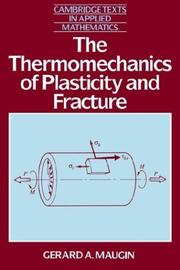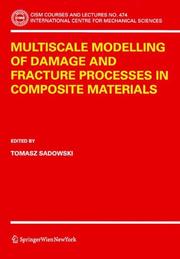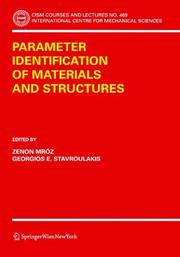| Listing 1 - 4 of 4 |
Sort by
|

ISBN: 0521397804 9780521397803 9781139172400 9780521394765 Year: 1992 Publisher: Cambridge Cambridge University Press
Abstract | Keywords | Export | Availability | Bookmark
 Loading...
Loading...Choose an application
- Reference Manager
- EndNote
- RefWorks (Direct export to RefWorks)
Plasticity --- Fracture mechanics --- Thermodynamics --- Mathematical models. --- 539.37 --- #KVIV:BB --- Deformation in general. Plane deformation. Three-dimensional deformation. Deformability --- 539.37 Deformation in general. Plane deformation. Three-dimensional deformation. Deformability --- Mathematical models --- Plasticity - Mathematical models. --- Fracture mechanics - Mathematical models. --- Thermodynamics - Mathematical models.
Book
ISBN: 9783709102831 9783709102824 3709102820 9786613075628 3709102839 1283075628 3709116651 Year: 2010 Volume: 522 Publisher: Vienna Springer Vienna
Abstract | Keywords | Export | Availability | Bookmark
 Loading...
Loading...Choose an application
- Reference Manager
- EndNote
- RefWorks (Direct export to RefWorks)
The latest state of simulation techniques to model plasticity and fracture in crystalline materials on the nano- and microscale is presented. Discrete dislocation mechanics and the neighbouring fields molecular dynamics and crystal plasticity are central parts. The physical phenomena, the theoretical basics, their mathematical description and the simulation techniques are introduced and important problems from the formation of dislocation structures to fatigue and fracture from the nano- to microscale as well as it’s impact on the macro behaviour are considered.
Engineering. --- Continuum Mechanics and Mechanics of Materials. --- Appl.Mathematics/Computational Methods of Engineering. --- Mathematical Methods in Physics. --- Mathematical physics. --- Engineering mathematics. --- Materials. --- Ingénierie --- Physique mathématique --- Mathématiques de l'ingénieur --- Matériaux --- Plasticity --- Fracture mechanics --- Mathematical models --- Fracture mechanics -- Mathematical models. --- Fracture mechanics. --- Mathematical models. --- Plasticity -- Mathematical models. --- Plasticity. --- Engineering & Applied Sciences --- Chemical & Materials Engineering --- Applied Mathematics --- Materials Science --- Crystals --- Plastic properties --- Physics. --- Applied mathematics. --- Continuum mechanics. --- Mechanical engineering. --- Mechanical Engineering. --- Crystallography --- Powders --- Solids --- Mechanics. --- Mechanics, Applied. --- Solid Mechanics. --- Mathematical and Computational Engineering. --- Physical mathematics --- Physics --- Engineering --- Engineering analysis --- Mathematical analysis --- Applied mechanics --- Engineering, Mechanical --- Engineering mathematics --- Classical mechanics --- Newtonian mechanics --- Dynamics --- Quantum theory --- Machinery --- Steam engineering --- Mathematics --- Natural philosophy --- Philosophy, Natural --- Physical sciences --- Plasticity - Mathematical models --- Fracture mechanics - Mathematical models --- Solids. --- Mathematical and Computational Engineering Applications. --- Data processing. --- Solid state physics --- Transparent solids

ISBN: 9783211381021 3211295585 9783211295588 3211381023 Year: 2005 Publisher: Vienna : Springer Vienna : Imprint: Springer,
Abstract | Keywords | Export | Availability | Bookmark
 Loading...
Loading...Choose an application
- Reference Manager
- EndNote
- RefWorks (Direct export to RefWorks)
Various types of composites are used in engineering practice. The most important are fibrous compositesy laminates and materials with a more complicated geometry of reinforcement in the form of short fibres and particles of various properties^ shapes and sizes. The aim of course was to understand the basic principles of damage growth and fracture processes in ceramic, polymer and metal matrix composites. Nowadays, it is widely recognized that important macroscopic properties like the macroscopic stiffness and strength, are governed by processes that occur at one to several scales below the level of observation. Understanding how these processes infiuence the reduction of stiffness and strength is essential for the analysis of existing and the design of improved composite materials. The study of how these various length scales can be linked together or taken into account simultaneously is particular attractive for composite materials, since they have a well-defined structure at the micro and meso-levels. Moreover, the microstructural and mesostructural levels are well-defined: the microstructural level can be associated with small particles or fibres, while the individual laminae can be indentified at the mesoscopic level. For this reason, advances in multiscale modelling and analysis made here, pertain directly to classes of materials which either have a range of relevant microstructural scales, such as metals, or do not have a very we- defined microstructure, e.g. cementitious composites. In particular, the fracture mechanics and optimization techniques for the design of polymer composite laminates against the delamination type of failure was discussed.
Engineering. --- Continuum Mechanics and Mechanics of Materials. --- Numerical and Computational Methods in Engineering. --- Materials. --- Ingénierie --- Matériaux --- Composite materials -- Fracture -- Mathematical models. --- Composite materials -- Mechanical properties -- Mathematical models. --- Fracture mechanics -- Mathematical models. --- Multiscale modeling. --- Composite materials --- Fracture mechanics --- Multiscale modeling --- Chemical & Materials Engineering --- Engineering & Applied Sciences --- Materials Science --- Applied Mathematics --- Mathematical models --- Fracture --- Mechanical properties --- Mathematical models. --- Multi-scale modeling --- Multiscale models --- Composites (Materials) --- Multiphase materials --- Reinforced solids --- Solids, Reinforced --- Two phase materials --- Computational intelligence. --- Continuum mechanics. --- Computational Intelligence. --- Mechanics of continua --- Elasticity --- Mechanics, Analytic --- Field theory (Physics) --- Intelligence, Computational --- Artificial intelligence --- Soft computing --- Construction --- Industrial arts --- Technology --- Multivariate analysis --- Materials --- Mechanics. --- Mechanics, Applied. --- Solid Mechanics. --- Applied mechanics --- Engineering, Mechanical --- Engineering mathematics --- Classical mechanics --- Newtonian mechanics --- Physics --- Dynamics --- Quantum theory

ISBN: 9783211381342 3211301518 9783211301517 3211381341 Year: 2005 Publisher: Vienna : Springer Vienna : Imprint: Springer,
Abstract | Keywords | Export | Availability | Bookmark
 Loading...
Loading...Choose an application
- Reference Manager
- EndNote
- RefWorks (Direct export to RefWorks)
The nature and the human creations are full of complex phenomena, which sometimes can be observed but rarely follow our hypotheses. The best we can do is to build a parametric model and then try to adjust the unknown parameters based on the available observations. This topic, called parameter identification, is discussed in this book for materials and structures. The present volume of lecture notes follows a very successful advanced school, which we had the honor to coordinate in Udine, October 6-10, 2003. The authors of this volume present a wide spectrum of theories, methods and applications related to inverse and parameter identification problems. We thank the invited lecturers and the authors of this book for their contributions, the participants of the course for their active participation and the interesting discussions as well as the people of CISMfor their hospitality and their well-known professional help. Zenon Mroz Georgios E. Stavroulakis CONTENTS Preface An overview of enhanced modal identification by L. Bolognini 1 The reciprocity gap functional for identifying defects and cracks by H. D. Bui, A. Constantinescu and H. Maigre 17 Some innovative industrial prospects centered on inverse analyses by G. Maier, M. Bocciarelli andR. Fedele 55 Identification of damage in beam and plate structures using parameter dependent modal changes and thermographic methods by Z. Mroz andK. Dems 95 Crack and flaw identification in statics and dynamics, using filter algorithms and soft computing by G. E, Stavroulakis, M. Engelhardt andH.
Engineering. --- Numerical and Computational Methods in Engineering. --- Computer Applications in Geosciences. --- Calculus of Variations and Optimal Control; Optimization. --- Artificial Intelligence (incl. Robotics). --- Artificial intelligence. --- Mathematical optimization. --- Ingénierie --- Intelligence artificielle --- Optimisation mathématique --- Fracture mechanics --- Modal analysis. --- Mathematical models. --- Fracture mechanics -- Mathematical models. --- Fracture mechanics. --- Modal analysis --- Engineering & Applied Sciences --- Civil & Environmental Engineering --- Civil Engineering --- Computer Science --- Mathematical models --- Structural analysis (Engineering) --- Structural engineering. --- Engineering, Structural --- Structures, Engineering of --- Architectural engineering --- Engineering, Architectural --- Structural mechanics --- Structures, Theory of --- Earth sciences. --- Calculus of variations. --- Computational intelligence. --- Computational Intelligence. --- Earth Sciences, general. --- Intelligence, Computational --- Artificial intelligence --- Soft computing --- Isoperimetrical problems --- Variations, Calculus of --- Maxima and minima --- AI (Artificial intelligence) --- Artificial thinking --- Electronic brains --- Intellectronics --- Intelligence, Artificial --- Intelligent machines --- Machine intelligence --- Thinking, Artificial --- Bionics --- Cognitive science --- Digital computer simulation --- Electronic data processing --- Logic machines --- Machine theory --- Self-organizing systems --- Simulation methods --- Fifth generation computers --- Neural computers --- Geosciences --- Environmental sciences --- Physical sciences --- Construction --- Industrial arts --- Technology --- Architecture --- Engineering --- Structural engineering --- Geography. --- Artificial Intelligence. --- Optimization (Mathematics) --- Optimization techniques --- Optimization theory --- Systems optimization --- Mathematical analysis --- Operations research --- System analysis --- Cosmography --- Earth sciences --- World history
| Listing 1 - 4 of 4 |
Sort by
|

 Search
Search Feedback
Feedback About UniCat
About UniCat  Help
Help News
News